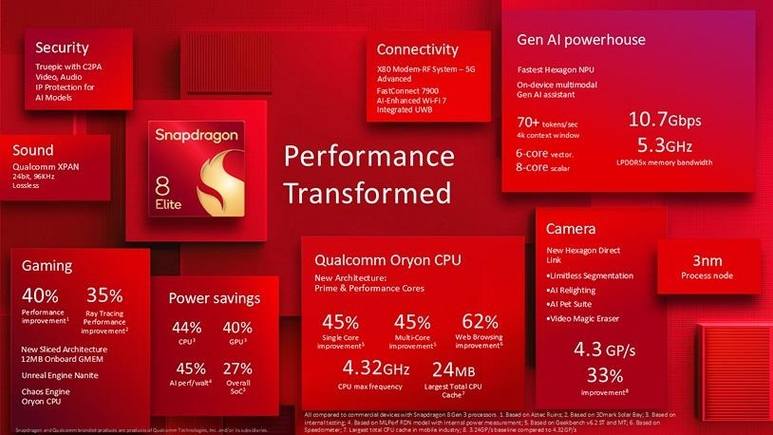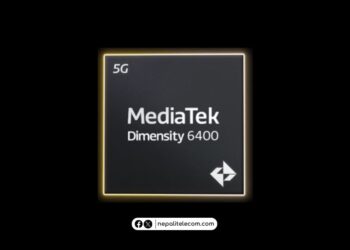Snapdragon 8 Elite Chipset Highlights:
- Qualcomm has launched Snapdragon 8 Elite chipset built on TSMC’s 3nm process
- Comes with 2 prime cores at 4.32 GHz and six performance cores at 3.53 GHz
- The Oryon CPU offers 45% single-core and multi-core performance improvements over the predecessor
Qualcomm has officially unveiled the Snapdragon 8 Elite, its newest and first 3nm flagship chipset at its annual Snapdragon Summit on Monday, October 21, 2024. It also confirms the company’s change in naming scheme as it was speculated to be the Snapdragon 8 Gen 4. Anyways, the SoC brings the fastest speed in smartphone processing, and further enhancements in Artificial Intelligence (AI) capability, energy efficiency, and graphics abilities.
The latest chipset is built on TSMC’s 3nm manufacturing process and succeeds the company’s popular Snapdragon 8 Gen 3 processor. The silicon debuts Qualcomm Oryon CPU to the mobile SoC after its launch for the PCs. The company claims that the new product is a “major leap forward” and expects consumer satisfaction from it.
Major Leap Forward …
“We are so excited to bring the power of Qualcomm Oryon to our Snapdragon mobile platforms for the first time. Earlier this year we debuted it in PCs, delivering remarkable experiences and unparalleled battery life to PC users, energizing the industry and getting the attention of consumers. Today, our second generation of the Qualcomm Oryon CPU debuts in our flagship Mobile Platform – it’s a major leap forward and we expect consumers to be thrilled with the new experiences enabled by our CPU technology” said Chris Patrick, senior vice president and general manager of mobile handsets, Qualcomm Technologies, Inc. “With leading CPU, GPU, and NPU capabilities, the Snapdragon 8 Elite delivers dramatic performance enhancements and power efficiency. In addition, it revolutionizes mobile experiences by offering personalized, multi-modal generative AI directly on the device enabling the understanding of speech, context, and images to enhance everything from productivity to creativity tasks while prioritizing user privacy.”
Check out: Ericsson, Qualcomm, and Thales to Take 5G into Space
So, What’s with the New Naming?
The new chipset has borrowed its title from the company’s silicon for laptops. Anyway, it was not a major surprise as there were already many suggestions referring to the Elite naming for it. It might have to do with the company’s desire to streamline its chipset’s identification.
Earlier this year, the semiconductor manufacturer introduced a Snapdragon X Elite processor for laptops. Now, it has used the same work in its mobile platform chipset. So, it could be assumed that the company wants to devise an easier and simpler naming for its products.
Here, we have covered all the major features of the Snapdragon 8 Elite.
Main Features of Snapdragon 8 Elite
1. Faster CPU Performance
One of the immediate features of the Snapdragon 8 Elite chipset is its speed. Powered by Qualcomm Oryon CPU, the chipset has two prime cores that clock in at 4.32 GHz and six performance cores that serve at 3.53 GHz. It’s Qualcomm’s new Prime and Performance core setup. The improvement? It delivers 45% single-core and 45% multi-core performance improvements over Snapdragon 8 Gen 3.
It’s an unprecedented leap in CPU speed and in terms of raw numbers, leaves behind the recently launched MediaTek’s Dimensity 9400 which features a maximum speed of 3.63 GHz.
The higher speed means smartphone users powered by this premium chipset will have it easy with multi-tasking, gaming, and graphics-heavy applications. In a nutshell, everything will run with a breeze. Likewise, Qualcomm says that the chipset will deliver 62% faster web browsing speeds, and with a 24 MB cache, switching between tasks will be much smoother.
2. Greater Power Efficiency
Another highlight of the advanced chipset is its efficiency with power which is a key selling point for the silicon and plays importantly in real-world usage too. The Snapdragon 8 Elite promises to save 44% in CPU power and 40% in GPU departments. The infographics mention that it is also energy efficiency by 45% in AI performance per watt. Overall, the chipset delivers 27% power saving.

All these power-saving features lead to better battery life and also fewer heating issues if it exists at all. So, users will receive some of the highest CPU performance while also seeing their battery life performing satisfactorily.
3. Fresh Camera Innovations
Smartphone photography gets better with each new iteration of chipsets and here’s no exception. In fact, Qualcomm promises a new leap in smartphone camera capabilities with its most powerful mobile platform. The silicon supports up to 48 MP triple camera setups and 4K video capture at 120fps.

Similarly, the chipset provides 4.3GP/s throughput to allow faster image processing and 33% better throughput which allows cameras to take high-quality images and videos. Likewise, the new Hexagon Direct Link delivers advanced AI-powered editing for photos and videos.
The Video Magic Eraser will be able to more easily remove unnecessary objects from videos. In the meantime, the Limitless Segmentation and AI Relighting tools bring further AI-enabled photo improvement ability.
4. More Powerful AI
The 3nm silicon is powered by a Hexagon NPU comprising a 6-core Vector Accelerator and 8-core Scalar Accelerator. In layman’s terms, this architecture helps deliver faster speeds in AI calculations and computations.
Qualcomm says that the SoC comes with 45% faster NPU3. To sum up, the generative AI on devices such as ChatGPT and Copilot will generate responses faster.
5. Gaming Gets Better
Qualcomm has always led the gaming prowess with its chipsets and that will take one notch up with its latest hardware. It says that the Snapdragon 8 Elite chipset delivers 40% better gaming performance which involves faster game loads, smoother gameplay, etc.
And let’s not forget that the Ray Tracing technology which means life-like details in the game improves by 35% giving mobile gamers a more immersive gaming experience.
More: Best 5G phones in Nepal with their latest price
6. Connectivity and Device Security
The chipset features a Snapdragon X80 Modem-RF System for more stable and high-performance 5G, Sub-6 GHz: 4×6 MIMO, WiFi 7 with 5.8 Gbps speed, Bluetooth 6.0, integrated ultra-wideband (UWB), etc. The Truepic with C2PA Security protects data on audio and video serving as a layer of device security.
7. Sound and Audio Improvements
The chipset also brings improvements in audio technology including 24-bit, 96kHz Lossless Audio, which ensures a high-quality and immersive audio experience.
Which smartphones will feature the Snapdragon 8 Elite chipset?
The upcoming flagship devices such as OnePlus 13, Xiaomi 15 Series, Xiaomi 15 Pro, iQOO 13, realme GT 7 Pro, Honor Magic 7 Series, ASUS ROG Phone 9, Red Magic 10 Pro, vivo X200 Ultra, and Samsung Galaxy S25 Series will feature the Snapdragon 8 Elite chipset.
More devices likely in 2025 will use this powerful chipset as well but due to its premium stature, the chipset will be used exclusively only in flagship smartphones. Its arrival could also mean that its predecessor Snapdragon 8 Gen 3 would be used in more upcoming upper-midrange handsets.
Our Conclusion
Snapdragon 8 Elite is the latest evolution in smartphone chipsets which comes with promise for faster CPU speed, power efficiency, and more innovation in camera and connectivity. Although Apple brought its 3nm chipset A17 Pro in 2023 powering the iPhone 15 Pro lineups and continued with more improvements with the A18 Pro in the iPhone 16 Pro, the race has now been further strengthened in the Android vs iPhones saga with Qualcomm joining the 3nm processor race.
With MediaTek and Qualcomm making their advancements with 3nm processors, other Android OEMs could also join the suit. Xiaomi has already made new progress for the 3nm chipset while Samsung has been at it since 2022 with its innovative Gate All Around (GAA) process. So, we could see the market competitiveness grow further in the coming years with more manufacturers making their own way into the more advanced processors for their smartphones.
What do you make of Qualcomm introducing its 3nm processor in Snapdragon 8 Elite and also changing its naming conventions? will the specs make it enticing to buy an Android powered by this chipset? Do offer your opinion in the comments below.













